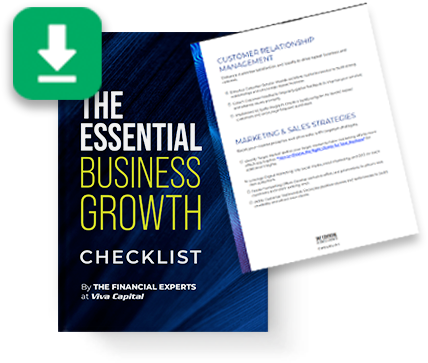
Worried about the effects of inflation on your business? It’s weighing on the minds of most Americans, with 93 percent rating it a very or moderately big problem, according to a recent Pew Research poll. Small business owners seem to agree. In all, 85 percent say they’re concerned about inflation, and one-third rank inflation as the biggest challenge they and their peers are facing today, per a U.S. Chamber of Commerce poll.
Are these concerns justified, and how exactly is inflation impacting businesses today? Get a full breakdown of the scope of the problem and how it may affect your business below.
Why is Inflation So High Right Now?
Many say government stimulus packages are the cause of the current inflation rate. The theory behind the argument is that the packages flooded cash into the economy. This might have been otherwise fine, but lockdowns and easing of COVID restrictions were slower than anticipated, which meant that the dollar dropped in value and didn’t spur economic activity as intended. Still, the current administration and others contend that the spending has helped the American economy recover faster. The debate rages on.
With that said, there’s little, if any, debate about how supply chain disruptions and demand have contributed to the problem. Prior to the pandemic, a “just in time” supply chain was widely leveraged. This means products aren’t built until they’re paid for, and materials don’t move until just before they’re needed in manufacturing. It’s a lean way to operate and mostly worked before the pandemic.
Of course, when demand for things like toilet paper and sanitizer unexpectedly skyrocketed, it all fell apart. A similar issue is being seen with semiconductor chips, which are used in everything from cars to computers. Pandemic lockdowns killed the market for new cars, so manufacturers pivoted to making chips for things like computers. The problem: production slowed due to outbreaks, and manufacturers have stayed the course of focusing on computers and other items that rose in demand during the pandemic. Vehicle demand is up again, but cars can’t be completed because there aren’t enough chips. This means vehicle prices are up. Used car prices jumped more than 40 percent, and new cars rose 12 percent, per USA Today.
Why is the Current Inflation Wave So Troubling?
The general public is divided and has been so since before the pandemic, in terms of whether they feel inflation or deflation is imminent. Understandably so, those feeling uncertain about the economy increased their precautionary savings, thus slowing economic recovery.
Meanwhile, economists have repeatedly gotten it wrong. Experts predicted inflation had peaked in August 2021, per Reuters reports. The inflation rate has climbed much higher, and hikes have lasted longer than initially expected.
Plus, demand is still skewed, and the supply chain issues are not worked out. Ford, for example, recently decided to ship out partially finished cars with the intent to ship chips to dealers at a later date. Similar issues are seen in a variety of industries.
The reality is that nobody knows how high inflation will climb or how long the current economic climate will last. Experts now predict the issue will persist into 2023. Meanwhile, consumers struggle to afford everyday items like food and gas. Between being short on cash and feeling unsure about the economy, their behavior is hard to predict too.
Do All Businesses Feel the Effects of Inflation in the Same Way?
Not all businesses feel the impact of inflation the same way. One only has to look at the difference between cars and computers to see it. Most are impacted by rising supply costs. More than two-thirds of businesses are planning to raise prices to cope with the hikes, according to Bloomberg. Around four in ten will bump their prices up a full ten percent. However, not all are feeling the pain of reduced consumer demand.
Companies that focus on essential goods and services, for example, are less impacted than those that focus on non-essential goods and services. Naturally, consumers will prioritize things like food and energy over entertainment when their dollar doesn’t stretch as far.
Price hikes can make or break it for businesses too. Those with fewer competitors can bump their rates without worrying that a competitor with lower pricing will cost them customers. A similar effect is seen in businesses with brand power. Consumers are willing to pay a bit more to work with names they know and trust.
Common Effects of Inflation on Business
Inflation creates a perfect storm for businesses in terms of cash flow and revenue.
- Overhead Increase: The cost of raw materials and manufacturing rises, driving up overhead expenses.
- Reduced Revenue: Because the dollar doesn’t go as far as it once did, consumers have less to spend. Many businesses see reduced overall sales.
- Reduced Profit: Afraid to lose customers over cost concerns, many businesses absorb the increased costs rather than raise prices. This, paired with lower sales volume, can reduce profit dramatically.
- Borrowing Difficulties: Naturally, these things increase the number of loan applications, so interest rates rise. Credit scores often suffer due to reduced revenue and profit. Because of these factors, fewer businesses qualify for credit, and those that do, pay more to borrow.
How Is Inflation Affecting Small Businesses Today?
The effects of inflation are felt throughout the business sector. More than 41 percent of small businesses say they’ve faced inflationary pressure in the past one to three months, according to a recent Veem study, up from 25 percent who say they’ve felt it over the past ten to 12 months. Nearly 40 percent say it’s impacting the cost of their supplies and 20 percent say they’ve considered taking out a business loan to help with cash flow issues.
Strategies to Survive Inflation
If the post-pandemic economy, interest rates, and effects of inflation are making it harder for your business to thrive, the following tips will help.
Revisit Your Pricing Strategy
Do a bit of market research to see if you can raise your prices a bit to cover some or all your additional costs. Remember, this strategy can result in customer churn, but less so if you have low competition, high brand awareness, or are in essential goods and services.
Evaluate Your Supply Chain
First and foremost, take steps to minimize risk in your supply chain. Beyond that, consider working with vendors to find out if there are ways to reduce your costs, such as increasing your orders or prepaying.
Cut Back on Non-Essential Expenses
Cull through your current budget to identify things you can cut or additional ways to save.
Evaluate Your Product or Revenue Mix
If you offer more than one product or service or have multiple billing tiers, find out if any are underperforming. Consider cutting them and any with low-profit margins.
You may also want to investigate whether inflation and the pandemic have opened new opportunities for you. For example, semiconductor chip manufacturers pivoted to computers, and apparel manufacturers moved to masks. This gave them added profitability under current conditions. However, strategies like this need to be closely monitored, as demand is likely to revert in the future.
Plan Ahead for Your Cash Flow Needs
If your business is coping with increased costs and reduced revenue, it’s likely you’ll require funding at some point in the future, even if you’re getting by now. Be prepared with an alternate funding source in the event you have difficulty with bank funding or cannot get it quickly enough. Alternative lending solutions may also be more ideal for those capitalizing on growth opportunities, such as seizing a greater market share or pivoting products and services.
Get a Complimentary Factoring Quote from Viva Capital
Invoice factoring works differently than traditional bank loans. Rather than taking money out in one large lump sum and paying it back with interest, you get a cash advance on your B2B invoices. The balance is paid off when your clients pay their invoices, so there’s no debt to pay back. You can also set up your factoring account before you need it and not leverage it until you do. If it sounds like invoice factoring might be the right solution to your business funding needs, connect with Viva for a complimentary rate quote.
- How Mid-Sized Companies Use Factoring to Drive Growth - May 23, 2025
- 10 Best Cash Flow and Budgeting Tools for Business Owners - May 2, 2025
- Business Factoring Success Stories: How Real Brands Benefit - March 31, 2025



